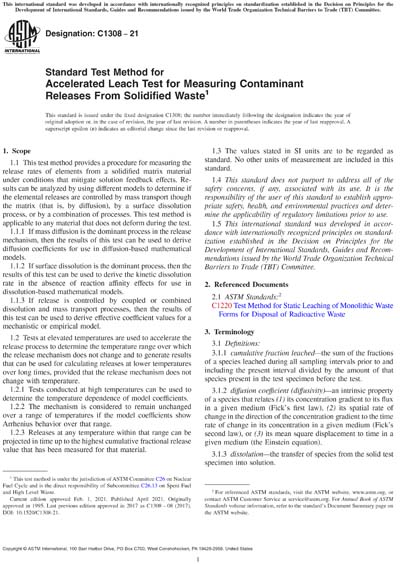Most recent
ASTM C1308-21
Standard Test Method for Accelerated Leach Test for Measuring Contaminant Releases From Solidified Waste
1.1 This test method provides a procedure for measuring the release rates of elements from a solidified matrix material under conditions that mitigate solution feedback effects. Results can be analyzed by using different models to determine if the elemental releases are controlled by mass transport though the matrix (that is, by diffusion), by a surface dissolution process, or by a combination of processes. This test method is applicable to any material that does not deform during the test.
1.1.1 If mass diffusion is the dominant process in the release mechanism, then the results of this test can be used to derive diffusion coefficients for use in diffusion-based mathematical models.
1.1.2 If surface dissolution is the dominant process, then the results of this test can be used to derive the kinetic dissolution rate in the absence of reaction affinity effects for use in dissolution-based mathematical models.
1.1.3 If release is controlled by coupled or combined dissolution and mass transport processes, then the results of this test can be used to derive effective coefficient values for a mechanistic or empirical model.
1.2 Tests at elevated temperatures are used to accelerate the release process to determine the temperature range over which the release mechanism does not change and to generate results that can be used for calculating releases at lower temperatures over long times, provided that the release mechanism does not change with temperature.
1.2.1 Tests conducted at high temperatures can be used to determine the temperature dependence of model coefficients.
1.2.2 The mechanism is considered to remain unchanged over a range of temperatures if the model coefficients show Arrhenius behavior over that range.
1.2.3 Releases at any temperature within that range can be projected in time up to the highest cumulative fractional release value that has been measured for that material.
1.3 The values stated in SI units are to be regarded as standard. No other units of measurement are included in this standard.
1.4 This standard does not purport to address all of the safety concerns, if any, associated with its use. It is the responsibility of the user of this standard to establish appropriate safety, health, and environmental practices and determine the applicability of regulatory limitations prior to use.
1.5 This international standard was developed in accordance with internationally recognized principles on standardization established in the Decision on Principles for the Development of International Standards, Guides and Recommendations issued by the World Trade Organization Technical Barriers to Trade (TBT) Committee.
Content Provider
ASTM International [astm]






